
Designing Dragons
Originally posted on Tony's blog in 2007
Despite all the fantasy stuff I’ve done in my career, I never get very excited about drawing dragons. Seriously. In fact, I kinda-sorta dread it.
Dragons have to be the most overwrought, over-rendered, over-exposed creatures in modern fantasy today. They are found in video games, books, toys, television and movies as they are integrated into almost all the world cultures since ancient times. Consequently, it seems like every possible rendition of this mythical beast has been done. How can I come up with something new, exciting and fresh after centuries of masters have already done so?
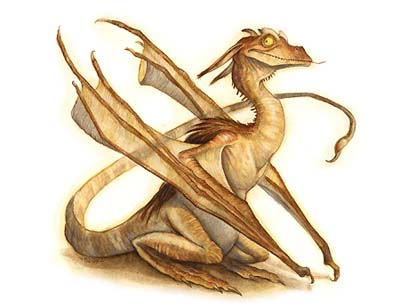
Honestly, I don’t like drawing them – even though I think they are awesome creatures and I love stories about them. There’s Smaug, Fafnir, Puff (the Magic dragon), Dragonslayer, Dragonheart, Dragonology, the Hydra, Falkor, Eragon and, of course, Dungeons & Dragons.
Ironically, despite my years of contributing art to this iconic fantasy game, I hardly ever rendered its namesake beast. There were quite a few gaming illustrators who had the dragon-thing covered, which was fine by me. I did however, do a few dragons for the gaming magazine of the same title. Even though they are on my site, I will post them here again.
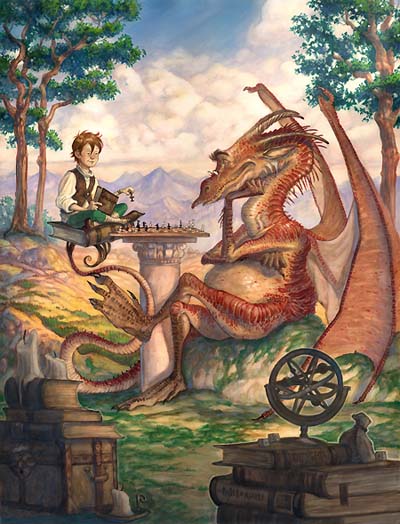
In these projects, I went more for a mood and setting over a novel design. The first image, of course, is about the joy of playing games. The second is more about illustrating the power of the female mage who has the ability to conjure up a massive dragon.
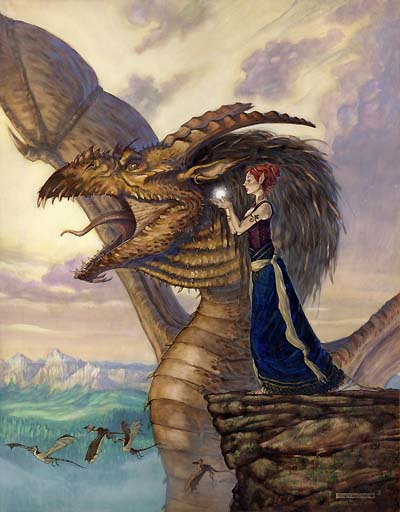
I recently cleaned these images up for a book anthology on dragons published by the French fantasy gallery, Galerie Daniel Maghen.
The gallery asked me to do a new illustration of a dragon – any kind of dragon at all doing dragony things. And they had all sorts of great dragon-scribes adding to the book – Todd Lockwood, Tom Kidd, Jean-Baptiste Monge, and Paul Bonner to name a few. Their dragon depictions were wonderful, and they were doing great dragony things – but I just wasn’t feeling it. Though I did have a sketch of an old knight fighting a slithery dragon:

…which they liked, but I felt it was a little trite. And, for some reason, I liked the energy of the sketch more than what I envisioned the final painting to be. Perhaps I am wrong, and I’ll get up the gusto to finally paint it one day.
Then I got clever. I decided to do my own take on a famous dragon image: Rapheal’s 1506 painting, “St. George & the Dragon”.

Mine was titled “Georgie Boy and the Backyard Dragon”. And I didn’t bother redesigning the dragon (or the horse head) and they didn’t like it. It wasn’t dragony enough I suppose. So I opted for the old dragon covers instead.
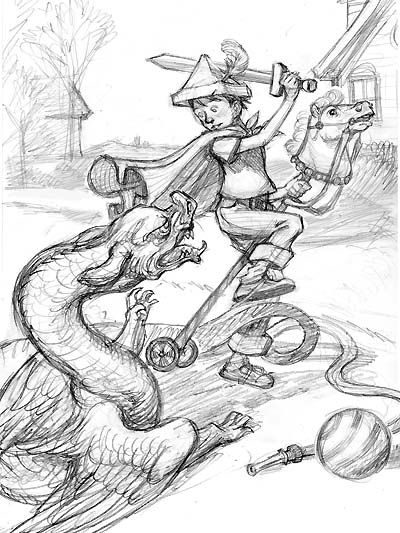
See? These are tough critters to get excited about rendering. At least they are for me…though I wonder if I should paint my rendition after all…hmmm.
I can see it on a greeting card with a note inside saying “Glad your feeling better – now go slay a dragon” or something cheesy and inspirational like “We all have our battles to fight and facing our fears is the biggest”.
Rapheal would be proud.
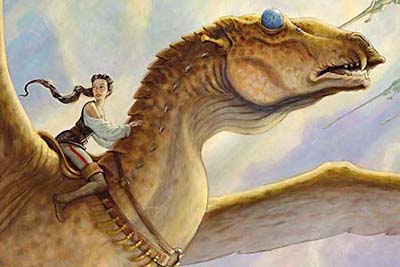
I first read Anne McCaffrey’s Dragonflight in late middle (or early high) school. It was after I had read The Hobbit, and before I plunged into Piers Anthony’s many Xanth novels. And, even though it had a female protagonist (and her dragon), I really enjoyed it. Since it took place on another planet, it reminded me of Princess Leia and Star Wars a bit…of course, I loved the cover by Michael Whelan (the real reason I read it):
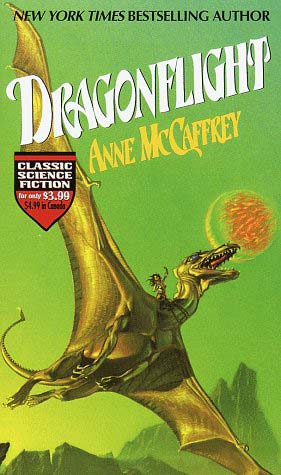
Imagine my surprise when I received a call from Delrey books in 2001 to do a “new” version of Pern – fully illustrated and aimed for younger readers. Wow!
Needless to say, I was giddy to be walking in the tracks of Whelan to bring my own view of Pern to life…but alas, it never really happened to the full extent of my vision.

You see, a book like this has a loooong history with a lot of people attached. Bringing in some new, “unknown artist” who wanted to tear the place apart and redesign everything, ruffled feathers. And so, many of my early space dragon designs were abandoned. I am posting some of these images here for the first time. The rest will have to wait for my Art of Tony D book…
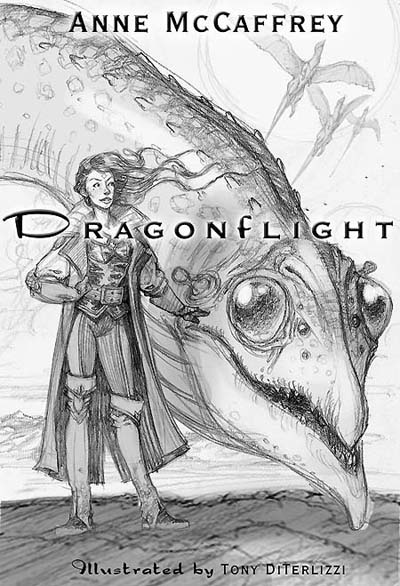
Here, for once, I did not feel the constraints I had felt when I designed the terrestrial dragons found in D&D. I was thinking less-dragon-more-space-creature, and had great fun exploring shapes and forms. I looked at a lot animals for the head design: antelope, hippo, and fledgling birds. Finally we settled on a horse-like form – not my first pick, but it certainly appeared gallant on the final cover.
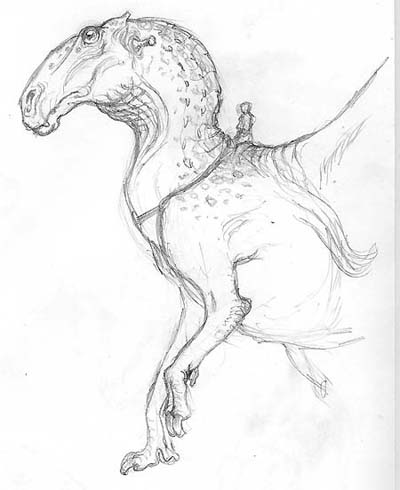
Like Dinosaur Summer, I am pretty sure my version of Dragonflight is out of print. However, the labor that went into this book was not a loss to me. Projects where I can explore ideas and flesh out concepts are always rewarding – even if it all doesn’t make it to the final product…which often happens with me. I do a lot of sketches before I even think of preparing for a final image.
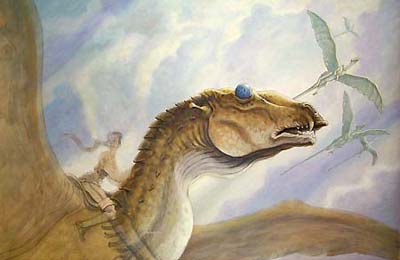
So, the dragon-design knowledge (as well as the world-building designs: people, clothing, architecture, etc) I gained here became very useful when I began laying the groundwork for a new series of books I had created with my good friend Holly Black…
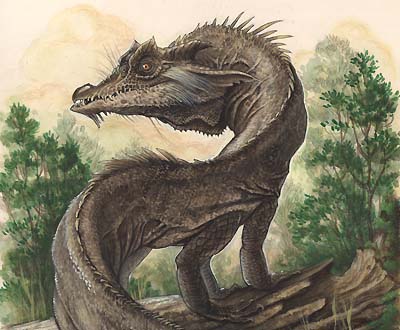
Early on, Holly and I thought it would be cool if the Spiderwick books slowly immersed the heroes into an entire world of fantasy. So, by the end of book 1, they finally see their house brownie, Thimbletack. By the climactic battle at the end of book 5, they are battling an evil ogre, his goblin army, and his brood of dragons.
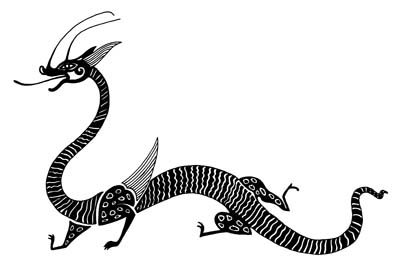
The Spiderwick dragon design was clearly inspired from Asian dragons. I had not done a long and lanky drake before, and was very excited about it. After the Pern project, I also felt less inhibited and returned to birdlike features for the head and face.
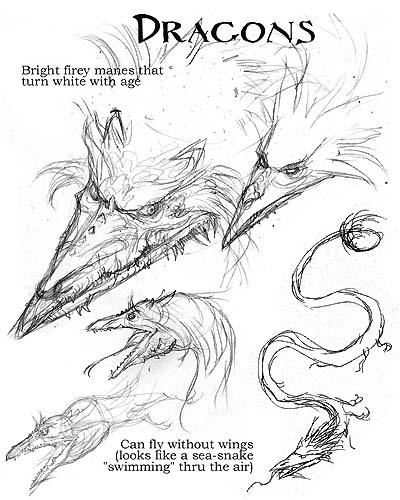
The multiple legs came purely by accident. I was sketching where exactly the legs should be placed on the body not erasing any of my previous attempts. I realized it looked kinda neat having multiple legs and found that I had stumbled onto something not seen (to my knowledge) in dragon design before. Woo! A breakthrough!
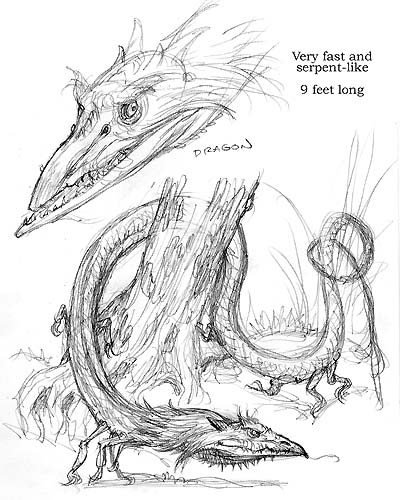
The other aspect that we pushed for was a return to a prehistoric-ish wild creature. You see, all of the creatures in the Spiderwick universe were reverse evolved from the “big fish” stories that had been told over centuries.

We developed the notion that as storytellers retold the tales of dragons, trolls and goblins, they embellished these beasts to tell a grander tale. So we tried to rewind these creatures back to what their original form may have been like. In the case of the dragon, I removed the wings (commonly seen on European drakes), made the beast smaller (about 9 feet in length), and removed fire-breathing and the ability to speak. We felt that if the dragon was less intelligent and more feral, it would be harder for our clever heroes to conquer.
One thing we did do, though, was embellish the toxicity of the creature. I wanted everything about the Spiderwick dragons to be poisonous – their breath, saliva, blood, claws, teeth, everything. They were Mulgarath’s weapon of mass destruction.
I based this idea on a story I had read about a knight who fought a particularly dangerous dragon and vanquished it. Afterwards, the slain beast’s blood ran into the ground killing all the local farmer’s crops. The idea of environmental impact by a destructive force really resonated with me, and it also fit well into the themes used within the Spiderwick books.
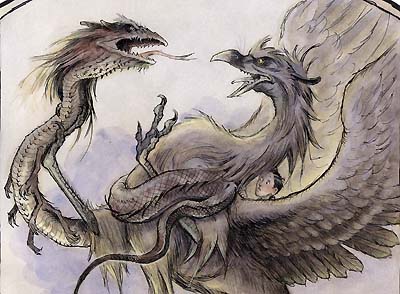
I started to realize it may actually be less about what a dragon looks like, and more about it actions. Really that’s what makes some of those favorite examples I listed earlier so memorable.
You can’t believe how relieved I am that I’ve figured this out. You see, my next chapter book involves a classic well-loved dragon…but more about that next time.
I’m teaching a class tomorrow at the Eric Carle Museum of Picture Book Art on creating your own unique interpretation of known fantastical creatures. One of the several designs the students can choose from will be a dragon, so I’ve amassed a library of some of my favorite images to share. It seems the timing is serendipitous with my ongoing dragon conversation here on my blog, so I decided to include a few.
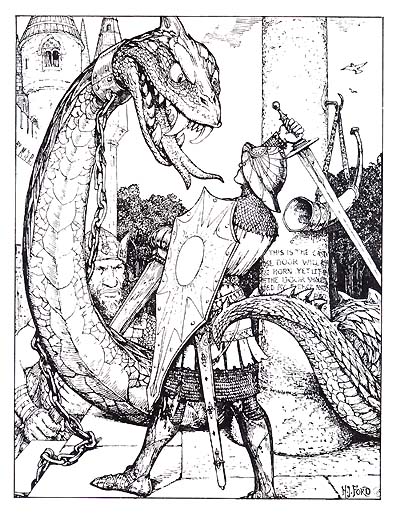
Henry J. Ford was best known for his illustrations in Andrew Lang’s Rainbow Fairy books which were a HUGE inspiration to the design of the Spiderwick books. He did this piece back in 1909.

Of course, many know Arthur Rackham’s work, and I have mentioned him many times as my main influence. This is Siegfried killing Fafnir in his book version of Wagner’s The Ring.

John Bauer is a Swedish illustrator from the turn-of-the-century. He was certainly influenced by Rackham, but had his own unique take on trolls and fairies. I am certain he was a big influence on Brian Froud. This is a title page to one of his troll books, done in 1915.
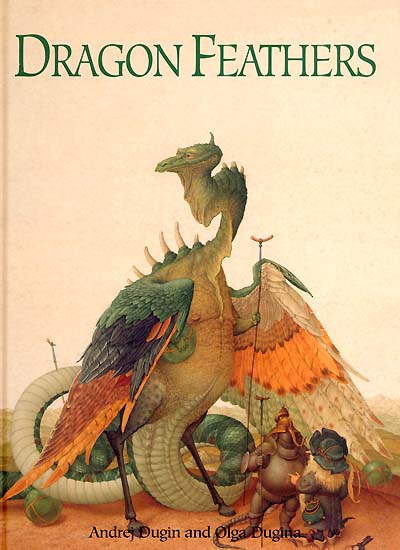
Moving ahead in time, this is the cover to a picture book called Dragon Feathers done by a Russian couple Andrej & Olga Dugina. I have seen some of their originals in person, and they are BEAUTIFUL. The detail is stunning. Try to look up their books next time you are in a library or book store, you won’t be disappointed. (and this dragon design is amazing!)

Last, but not least, is one of my favorite dragon designs. This was done by Ernest H. Shepard, best known for his work in A. A. Milne’s Winnie-the-Pooh books and Kenneth Grahame’s Wind in the Willows. This is an image from another Kenneth Grahame short story, The Reluctant Dragon, from a book titled Dream Days.
This image means the most at the moment, for you see my next book, Kenny & The Dragon, is a fully-illustrated retelling of this very story. More to come next post…
So, as I mentioned in my last post, I am waist-deep in my new book project Kenny & The Dragon. It is a retelling of the Kenneth Grahame short story, The Reluctant Dragon, which was found in his book Dream Days published back in 1898.
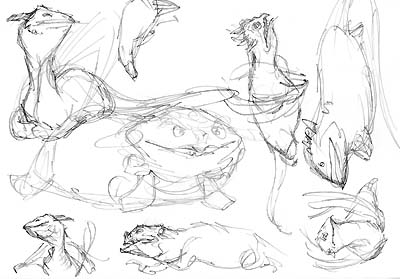
This is one of my favorite dragon stories that I remember as a child. The surprise here is that the dragon is hardly the fierce, fire-breathing variety – he’s more a poet and a pacifist. There is also a slight humor in both the original version and my retelling, so I wanted his design to reflect that, yet still be an interesting and unusual creature.
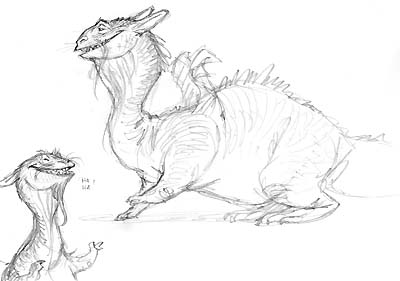
My first attempt was very closely based on Ernest Shepard’s design in the original version. I quickly abandoned it and moved along feeling there was nothing more I could add…
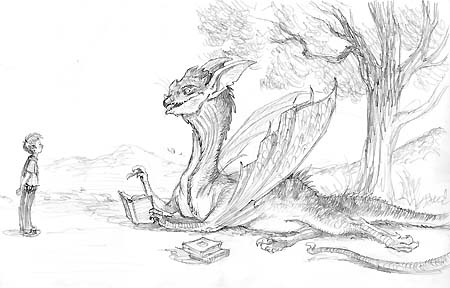
I came close to this birdlike beaky version (remember those Pern dragons?) which I felt looked intelligent enough to speak, read and write, but wasn’t quite warm enough for the mood of the text that I had written.

This turtle-inspired version was more on the right track…but I still wasn’t quite there yet.
For my rendition of The Reluctant Dragon, I wanted to create a comfy, cozy world reminiscent of Wind in the Willows. My motto for it was “a warm cup of tea”. In other words, I wanted the mood of the book to evoke the comfortable feeling you get when you curl up with a warm cup of tea on a lazy afternoon. Jim Henson’s adaptation of Emmett Otter’s Jug-Band-Christmas is very similar in tone to what I was aiming for, so the dragon needed to feel like he was from that world.
That said, I replaced all of the human characters in the story with animals. Once I started designing the main characters (which I will showcase in a later post), I was able to push the dragon design to where I wanted it.
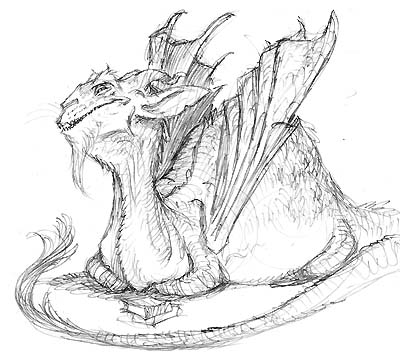
I referenced cats and goats for the main inspiration and worked from there. I tried various images showing the friendship forged between the hero, a rabbit named Kenny, and the dragon. Some were too epic, like this one:

…and others didn’t feel quite right mood-wise. In fact, this one felt a little Neverending Story-ish to me. So I kept exploring…

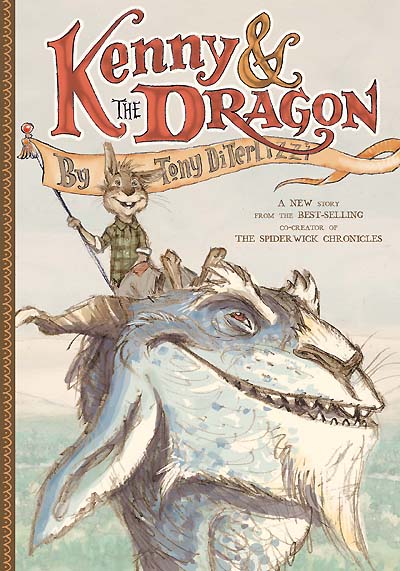
This one above, an early color comp for the jacket, was getting closer. You certainly get that they are friends, and the dragon face has a lot of personality. But I wanted a little movement, a little action to create some real interaction between the dragon and the hero. At last I arrived at this:
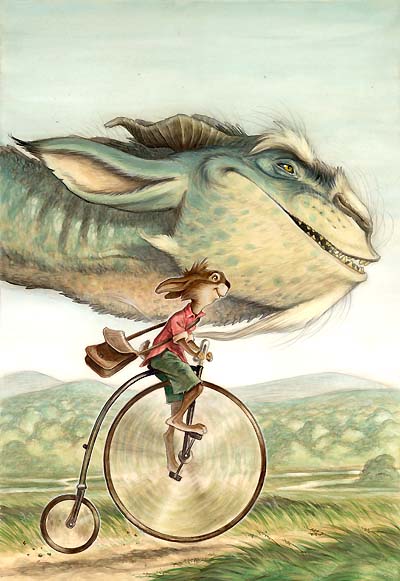
Its worth noting that the color of the scales, I think, sets it apart from other depictions. The original text mentions the dragon being blue in tone and I really liked that unexpected element a lot (it seems like so many dragons are red, brown or black). Angela had me push it into this greenish-blue to put my own spin on it, and I like the way it feels…plus Saphira (in Eragon) is blue.
So what did i gain from this design journey? I learned that a dragon – like a human – has been rendered countless times for centuries by many talented artists. To find an exciting and unique design, I need to understand the creature and what sort of character it represents. Though I still think these beasties are tough to render, I have even more appreciation to those who offer up something new and exciting to such a classic denizen of fantasy.
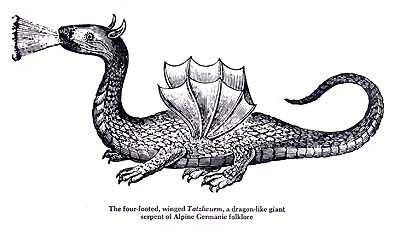

 Menu
Menu Connect
Connect







































